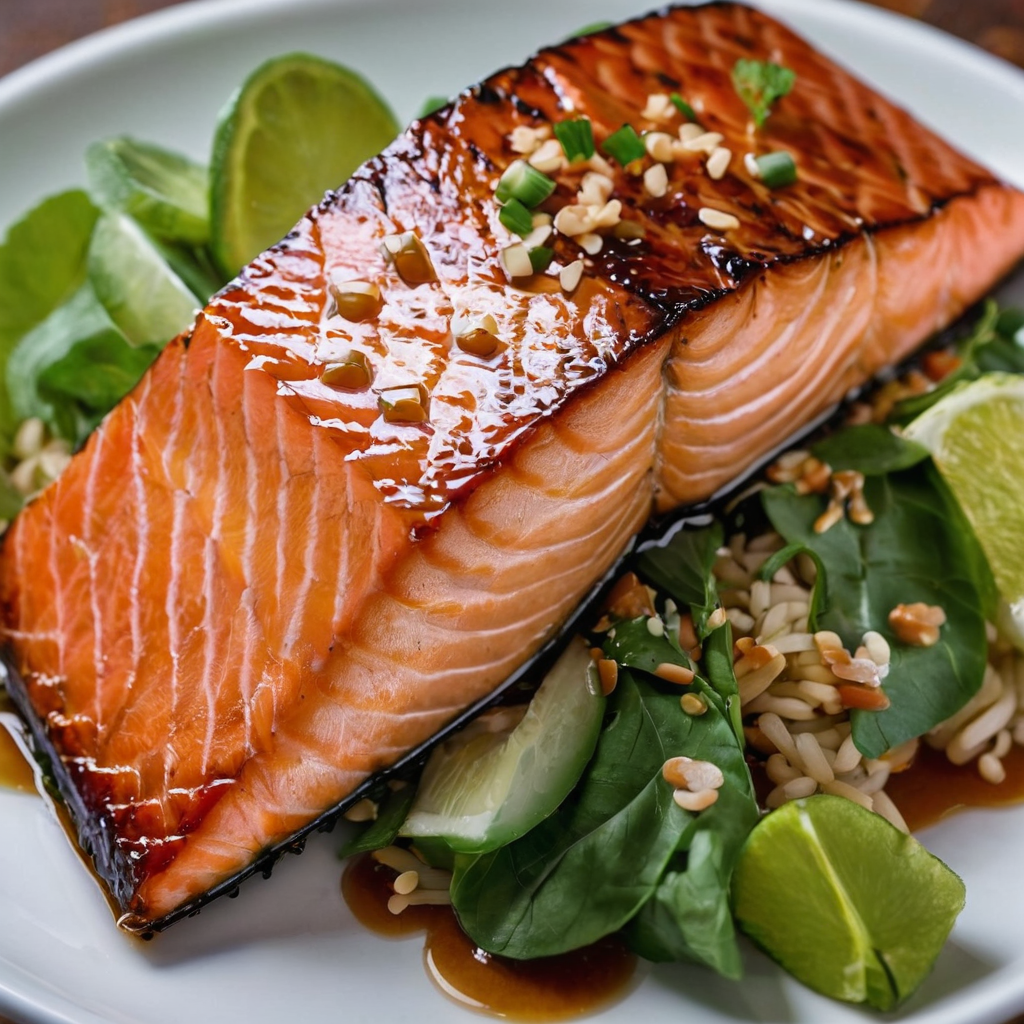A Delicious and Easy Recipe
If you’re a seafood lover, you’ve probably tried salmon in many different ways. But have you ever tried caramelized salmon? This sweet and savory dish is a game changer for salmon lovers. The caramelization process brings out the natural sweetness of the salmon and creates a crispy exterior that is hard to resist.
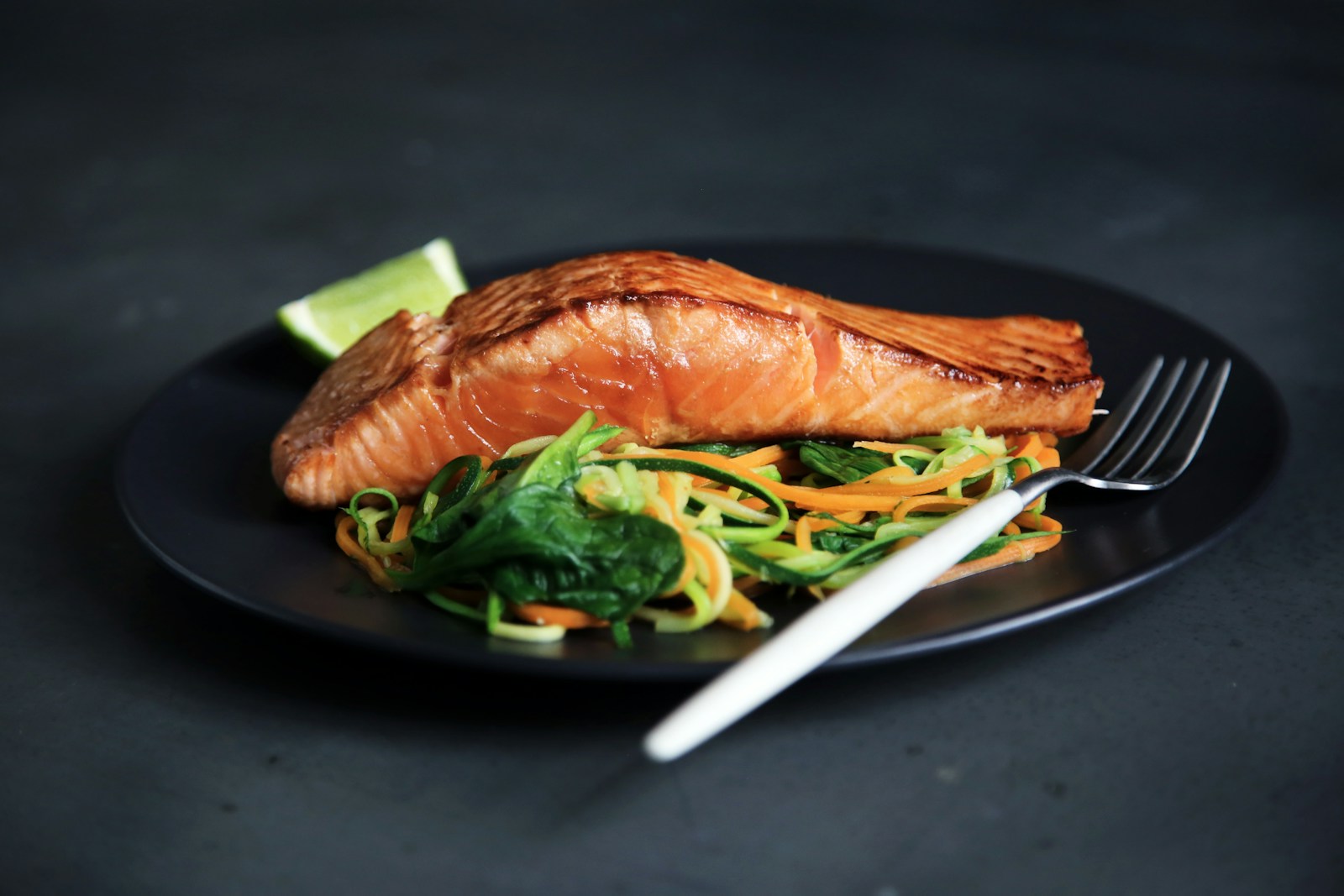
To make caramelized salmon, you’ll need a few simple ingredients like sugar, salt, and pepper. The salmon is coated in the sugar mixture and then pan-fried until it’s caramelized and crispy on the outside. The end result is a dish that is both sweet and savory, with a perfect balance of flavors.
Using the active voice and transition words, you can easily make caramelized salmon at home. This dish is perfect for a weeknight dinner or a special occasion. With its delicious flavor and easy preparation, caramelized salmon is sure to become a new favorite in your recipe collection.
Selecting Quality Salmon

When it comes to making Caramelized Salmon, selecting the right salmon is crucial to ensure that the dish turns out perfectly. Here are some tips to help you choose quality salmon for your recipe.
Fresh vs. Frozen Salmon
Fresh salmon is always the best choice for any recipe, including Caramelized Salmon. When buying fresh salmon, look for fillets that are firm, moist, and have a bright color. The flesh should be translucent and not have any signs of browning or discoloration. If you are unsure about the freshness of the salmon, ask the fishmonger for advice.
If fresh salmon is not available, frozen salmon can be a good alternative. Look for frozen salmon that has been flash-frozen, which helps to lock in the flavor and nutrients. Avoid salmon that has been frozen and thawed multiple times, as this can affect the texture and taste of the fish.
Salmon Varieties
There are several varieties of salmon available in the market, each with its own unique flavor and texture. The most common varieties are:
- Atlantic salmon: This is the most widely available salmon variety and is known for its mild flavor and tender flesh.
- Coho salmon: This variety has a slightly more pronounced flavor than Atlantic salmon and is often used in sushi and sashimi.
- Chinook salmon: Also known as king salmon, this variety has a rich, buttery flavor and is often considered the best-tasting salmon.
- Sockeye salmon: This variety has a deep red color and a strong, rich flavor that pairs well with bold seasonings.
When selecting salmon for Caramelized Salmon, choose a variety that has a firm texture and a rich flavor, such as Chinook or Sockeye salmon. These varieties hold up well to the caramelization process and will provide a delicious and flavorful dish.
For more information on selecting quality salmon, check out this guide.
Preparing the Salmon
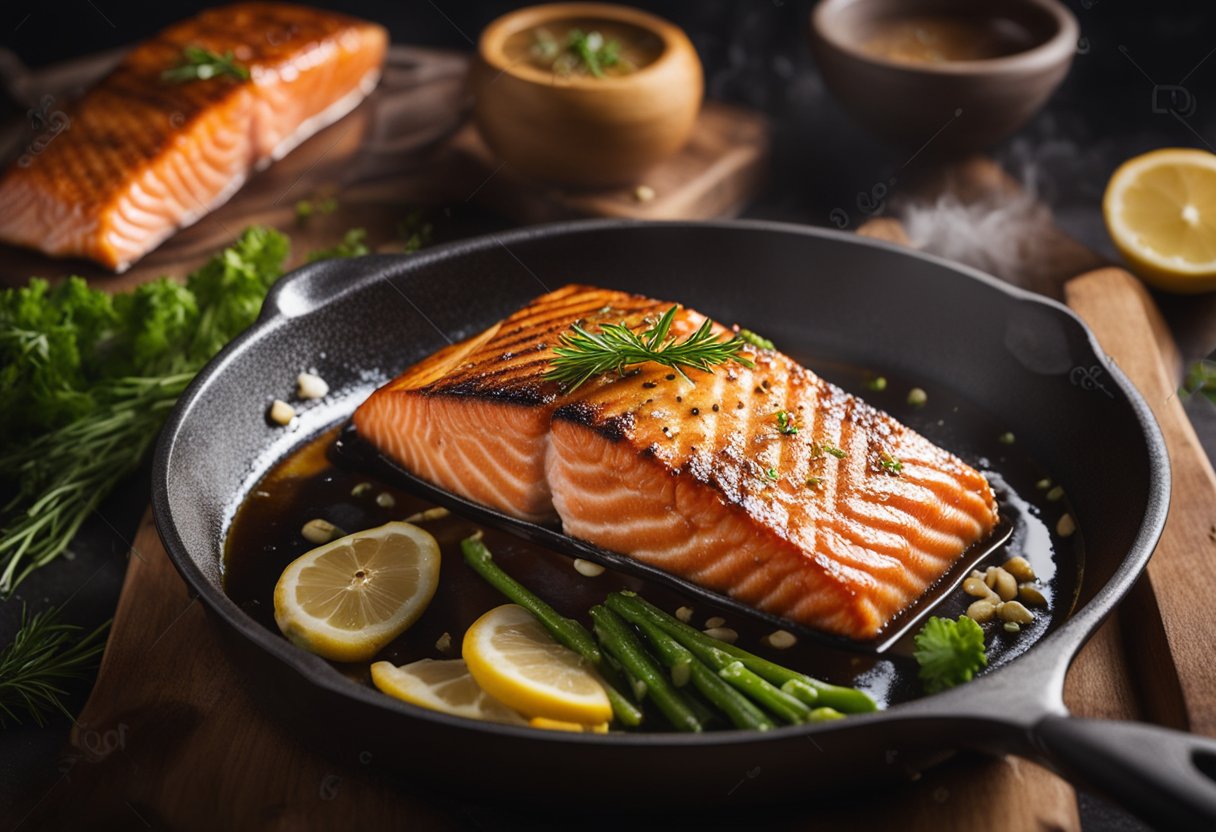
When it comes to preparing Caramelized Salmon, there are a few important steps you need to follow to ensure the best possible outcome. In this section, we will go over some essential techniques to help you get started.
Scaling and Filleting
Before you can begin cooking your salmon, you need to prepare it properly. The first step is to scale the fish. This process involves removing the scales from the skin, which can be done with a fish scaler or the back of a knife.
Once the salmon is scaled, you’ll need to fillet it to remove the bones and skin. This can be done by making a cut behind the gills and along the spine, then running the knife down the length of the fish to separate the flesh from the bones. You can then remove the skin by sliding the knife between the skin and flesh, using a sawing motion to gently separate the two.
Marinating Techniques
Marinating your salmon is an essential step in creating the perfect Caramelized Salmon. There are several different techniques you can use to marinate your fish, depending on your personal preference.
One popular method is to use a mixture of fish sauce and pepper. Simply combine the salmon, fish sauce, and pepper in a bowl, making sure to coat the salmon with the marinade. For the best flavor, let the fish marinate for at least an hour before cooking.
Another option is to use a blend of white and brown sugar, sea salt, black pepper, and a dash of nutmeg. This coating will help create a delicious caramelized crust on the outside of the fish, while still allowing the salmon to shine through.
No matter which marinating technique you choose, it’s important to let the fish sit in the marinade for at least 15 minutes before cooking. This will allow the flavors to penetrate the fish and create a delicious, flavorful dish.
By following these simple steps for scaling, filleting, and marinating your salmon, you’ll be well on your way to creating a delicious and perfectly caramelized dish.
Caramelization Basics
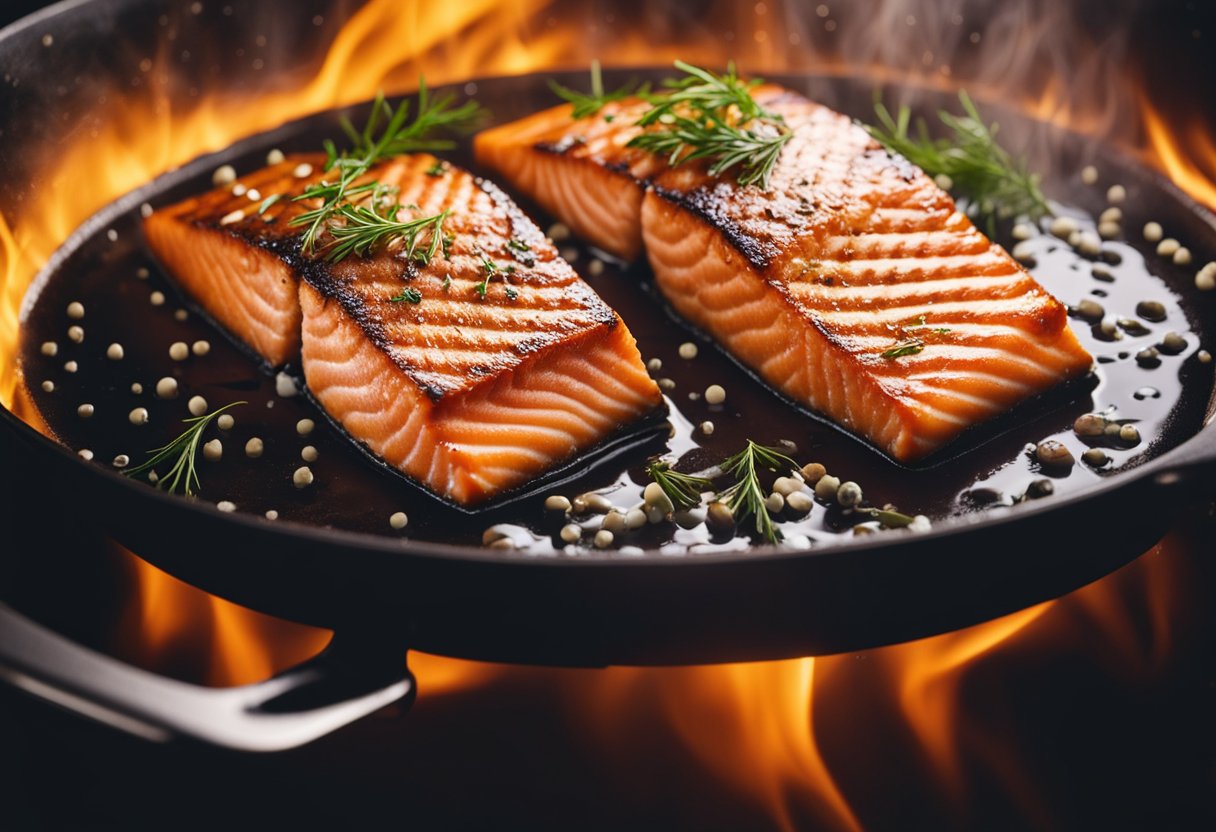
Caramelization is a cooking technique that involves heating sugar to create a sweet, nutty flavor and a distinctive brown color. This process can be applied to a variety of foods, including vegetables, fruits, and meats, such as salmon. In this section, we’ll explore the science of caramelization and the agents used to create it.
The Science of Caramelization
Caramelization occurs when sugar molecules are heated to a high temperature, causing them to break down and form new compounds. As the sugar molecules break down, they release water and create a range of flavors and aromas. The Maillard reaction, a chemical reaction between amino acids and reducing sugars, also contributes to the browning and flavor development that occurs during caramelization.
When caramelizing salmon, the heat causes the natural sugars in the fish to break down and create a caramelized crust. The result is a sweet and savory flavor that complements the natural taste of the fish.
Caramelizing Agents
To caramelize salmon, you’ll need a caramelizing agent. Common agents include sugar, honey, maple syrup, and balsamic vinegar. These agents add sweetness and help create a caramelized crust on the salmon.
When using sugar as a caramelizing agent, it’s important to use a low heat and to monitor the sugar closely to prevent burning. Honey and maple syrup are also great options for caramelizing salmon, as they add a unique flavor and help create a caramelized crust.
In summary, caramelization is a cooking technique that can add depth of flavor and visual appeal to a variety of foods, including salmon. By understanding the science of caramelization and using the right agents, you can create a delicious caramelized salmon dish that is sure to impress.
Cooking Techniques

When it comes to cooking caramelized salmon, there are two main techniques you can use: pan searing and oven roasting. Both methods are easy to follow and produce delicious results.
Pan Searing
Pan searing is a quick and easy way to cook salmon. To start, heat a non-stick skillet over medium-high heat and add a small amount of oil. Once the pan is hot, add the salmon fillets, skin-side down. Cook for about 4-5 minutes until the skin is crispy and golden brown. Flip the salmon over and cook for another 2-3 minutes until the flesh is cooked through.
One important tip for pan-searing salmon is to make sure the pan is hot enough before adding the fish. This will ensure that the skin gets crispy and doesn’t stick to the pan. Another tip is to season the salmon with salt and pepper before cooking to enhance the flavor.
Oven Roasting
Oven roasting is another great way to cook caramelized salmon. Preheat your oven to 425°F (220°C) and line a baking sheet with parchment paper. Place the salmon fillets on the baking sheet and brush them with a mixture of brown sugar, olive oil, salt, and pepper. Roast the salmon in the oven for about 12-15 minutes until the flesh is cooked through and the sugar has caramelized.
One advantage of oven roasting is that you can cook multiple fillets at once, making it a great option for feeding a crowd. Another benefit is that you can easily customize the flavor of the salmon by adding different seasonings or marinades.
No matter which cooking technique you choose, make sure to use fresh salmon and follow the instructions carefully. With a little practice, you can create a delicious and impressive caramelized salmon dish that will impress your guests.
Flavor Pairings and Sauces
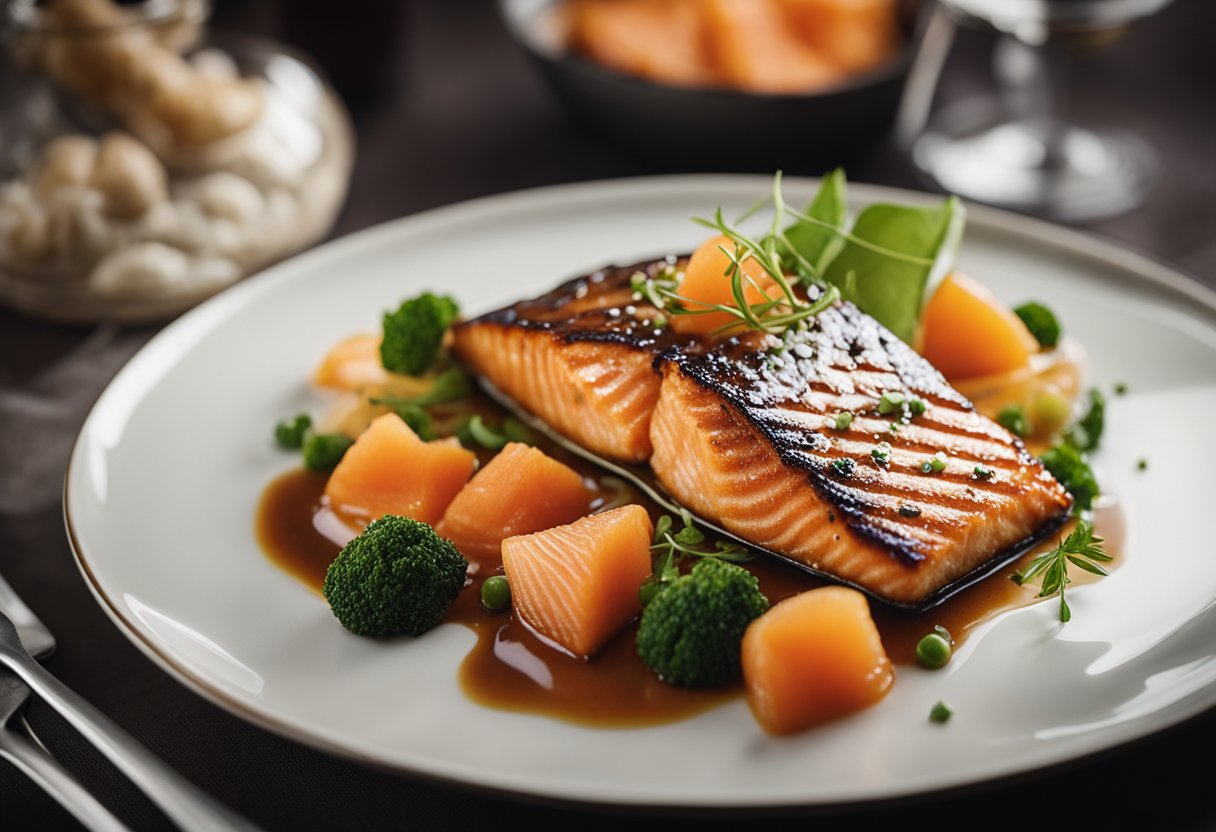
Complementary Flavors
Caramelized salmon is a dish that is packed with flavor, but it can be even better when paired with the right flavors. The sweetness of the caramelization pairs well with tangy and acidic flavors. A squeeze of lemon or lime juice on top of the salmon before serving can help to balance out the sweetness of the caramelization.
Additionally, caramelized salmon pairs well with a variety of vegetables. Roasted asparagus or Brussels sprouts are great options for a side dish. The bitterness of the vegetables helps to cut through the sweetness of the caramelization.
Sauce Recipes
If you want to take your caramelized salmon to the next level, consider serving it with a flavorful sauce. Here are a few sauce recipes that pair well with caramelized salmon:
- Honey Mustard Sauce: Combine equal parts honey and Dijon mustard, then add a splash of apple cider vinegar and a pinch of salt. Whisk until well combined and serve on top of the salmon.
- Soy Ginger Sauce: Combine soy sauce, minced ginger, minced garlic, and a splash of rice vinegar in a small bowl. Whisk until well combined and serve on top of the salmon.
- Cilantro Lime Crema: Combine sour cream, fresh cilantro, lime juice, and a pinch of salt in a food processor. Pulse until well combined and serve on top of the salmon.
These sauces add a burst of flavor to the salmon and help to balance out the sweetness of the caramelization. Experiment with different sauce recipes to find your favorite pairing.
External links:
- 15 Sauces for Salmon (Easy, Flavorful + Delicious)
- What Pairs Well with Salmon: A Delicious Guide to Flavor Combinations
Plating and Presentation
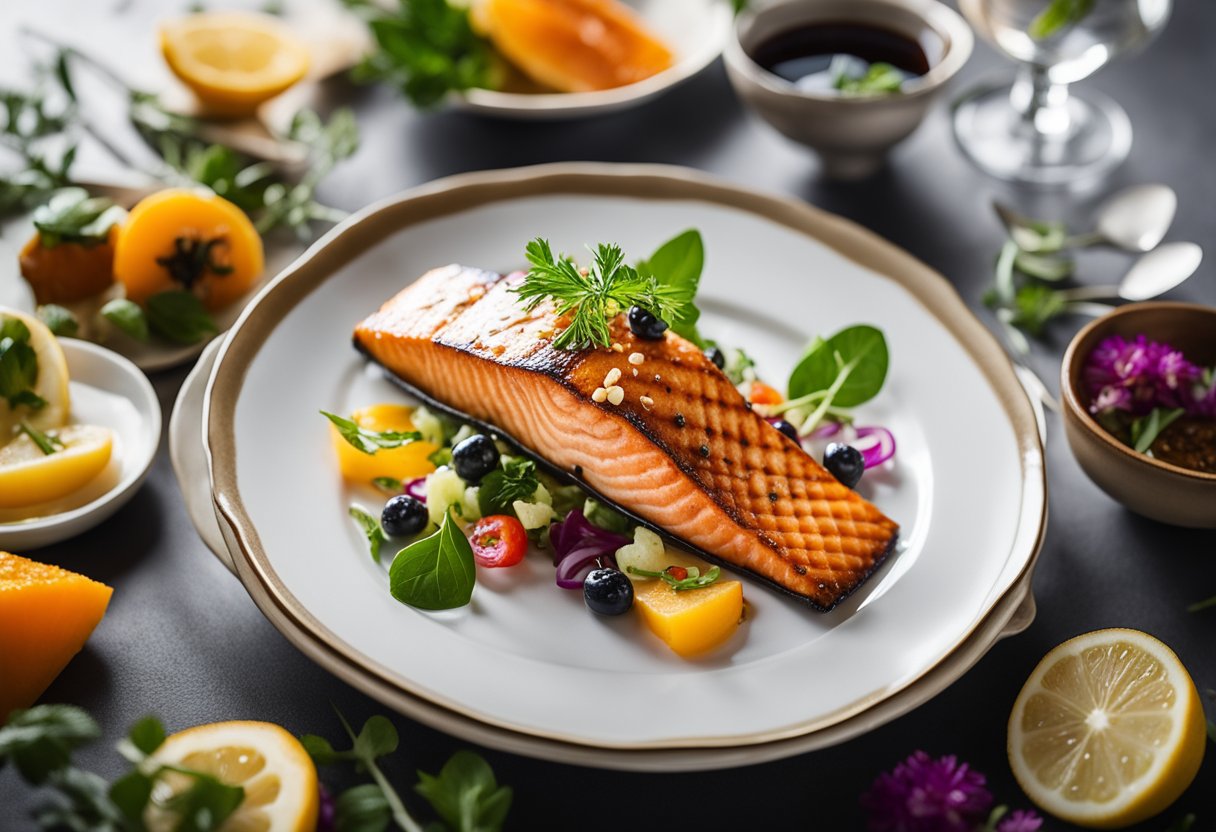
When it comes to plating and presentation, caramelized salmon is a dish that can be elevated with some simple techniques. Here are some tips to help you make your caramelized salmon look as good as it tastes.
Garnishing Techniques
Garnishing is an essential part of plating, and it can make a big difference in the overall appearance of your dish. Here are some techniques you can use to garnish your caramelized salmon:
- Citrus wedges: A wedge of lemon or lime can add a pop of color and a burst of freshness to your dish.
- Herbs: Fresh herbs like parsley, dill, or chives can add a touch of green and a subtle flavor to your dish.
- Microgreens: These tiny greens are packed with flavor and can add a delicate touch to your dish.
- Sauce: Drizzling a sauce over your caramelized salmon can add a beautiful shine and a burst of flavor. Try a simple lemon butter sauce or a sweet and spicy glaze.
Serving Suggestions
Caramelized salmon is a versatile dish that can be served in many ways. Here are some serving suggestions to inspire you:
- Rice: Serve your caramelized salmon over a bed of rice for a filling and satisfying meal.
- Salad: Top a bed of greens with your caramelized salmon for a light and refreshing meal.
- Vegetables: Roasted or grilled vegetables like asparagus, broccoli, or zucchini can make a great side dish for your caramelized salmon.
Remember, presentation is key when it comes to plating your caramelized salmon. Take the time to arrange your dish in an appealing way, and don’t be afraid to get creative with your garnishes. With a little effort, you can turn your caramelized salmon into a work of art.
Pairings with Caramelized Salmon
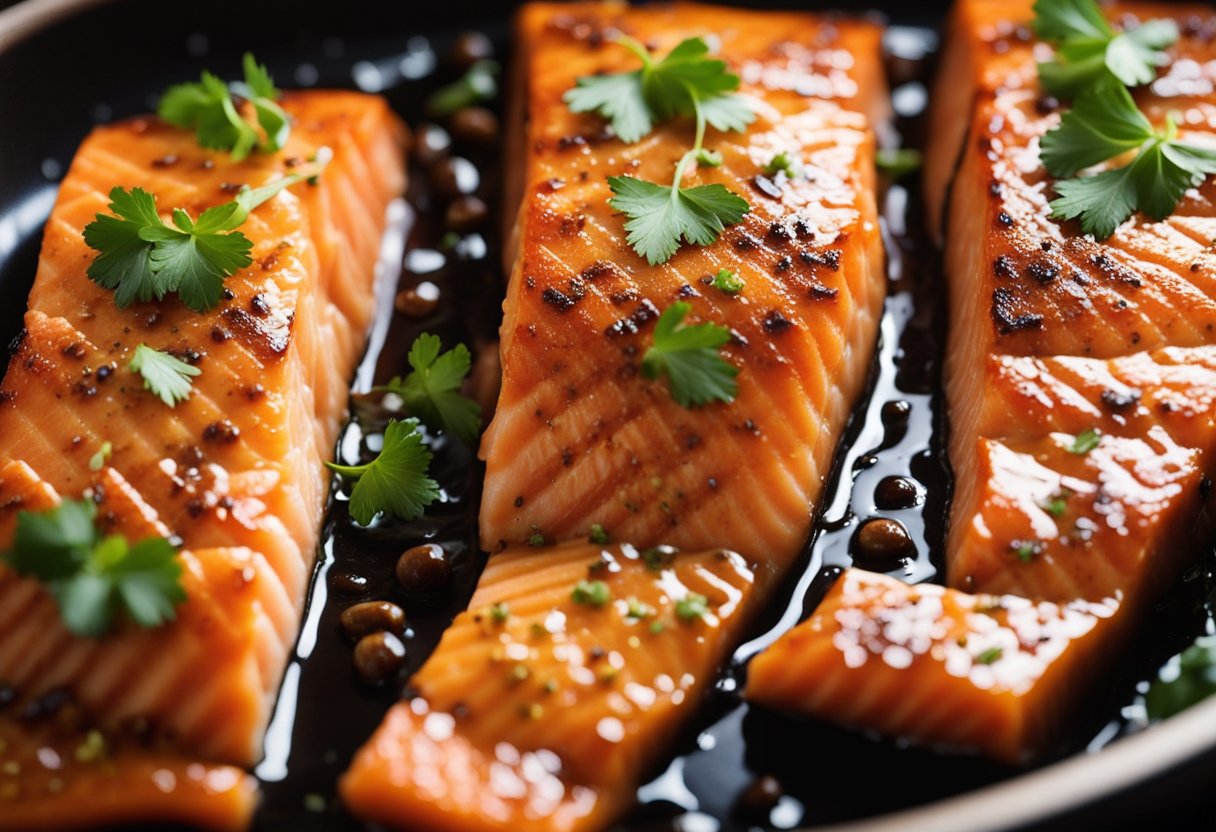
When it comes to pairing caramelized salmon with other foods and beverages, there are a few things to keep in mind. The rich, sweet flavors of the caramelized salmon can be complemented by certain wines and side dishes, while other options may clash with the dish. Here are some recommendations for pairing caramelized salmon.
Wine and Beverage Pairings
If you’re looking for a wine to pair with caramelized salmon, consider a full-bodied white wine like Chardonnay or Viognier. These wines have a rich and buttery flavor that pairs well with the sweetness of the caramelized salmon. If you prefer red wine, try a Pinot Noir or a light-bodied Merlot. These wines have a fruity and earthy flavor that complements the salmon without overpowering it.
If you prefer non-alcoholic beverages, try pairing caramelized salmon with a citrusy iced tea or a sparkling water with a slice of lemon. These drinks have a refreshing taste that can balance out the richness of the salmon.
Side Dishes
When it comes to side dishes, there are several options that pair well with caramelized salmon. Asparagus is a classic choice, as its earthy flavor complements the salmon’s sweetness. You can also try serving the salmon alongside a simple green salad with a light vinaigrette dressing.
If you’re looking for something heartier, consider serving the salmon with roasted sweet potatoes or mashed potatoes. The sweetness of the potatoes can complement the caramelized flavor of the salmon. Another option is to serve the salmon with a side of sautéed spinach or kale, which can add a healthy and flavorful touch to the dish.
In summary, when pairing caramelized salmon, consider wines and beverages that have a rich and buttery flavor, as well as side dishes that complement the salmon’s sweetness. With the right pairings, you can create a delicious and balanced meal that will satisfy your taste buds.
Nutritional Information
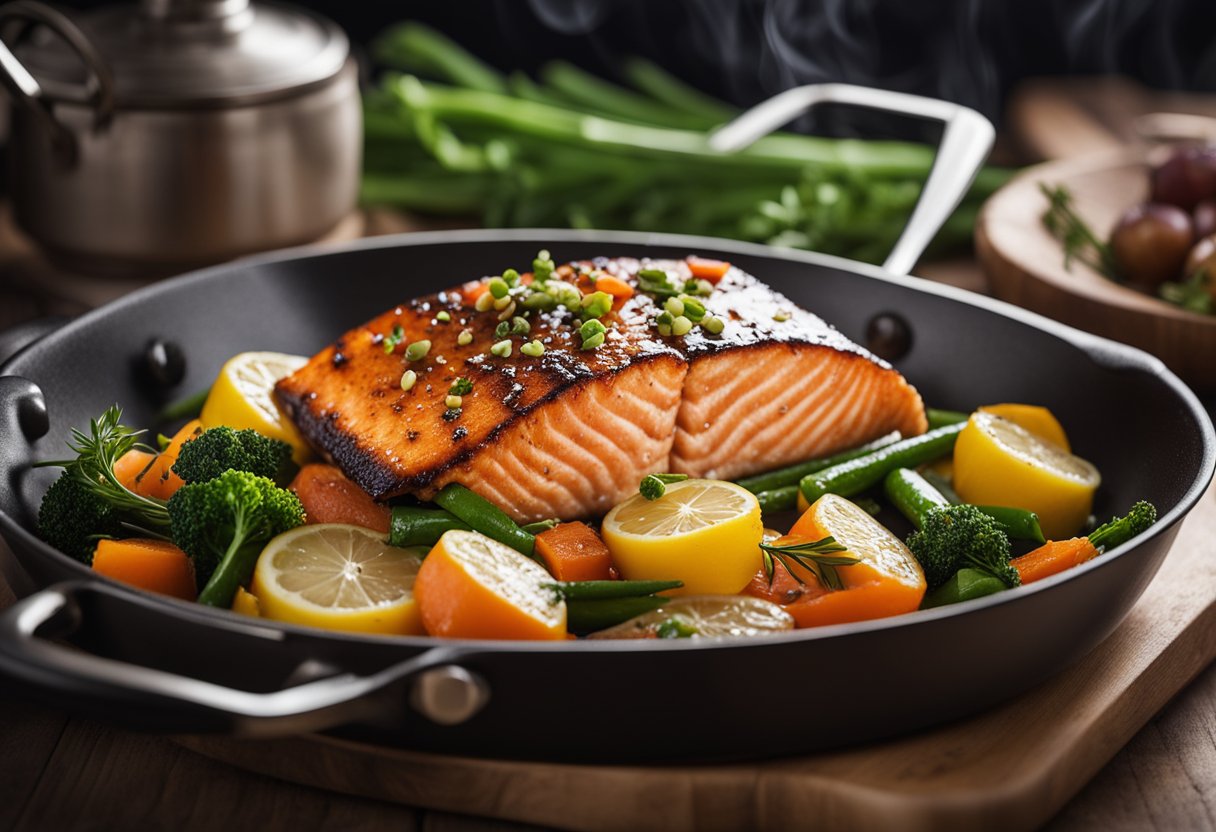
When it comes to nutrition, caramelized salmon is a great source of protein, omega-3 fatty acids, and essential vitamins and minerals. In this section, we will explore the health benefits and dietary considerations of this delicious dish.
Health Benefits
Caramelized salmon is a nutritious food that may offer several health benefits. Here are some of the key benefits:
- High in Protein: Salmon is an excellent source of protein, which is essential for building and repairing tissues in the body. A 3-ounce serving of salmon contains about 17 grams of protein 1.
- Rich in Omega-3 Fatty Acids: Salmon is also a great source of omega-3 fatty acids, which are important for heart health, brain function, and reducing inflammation in the body. A 3-ounce serving of salmon contains about 1.5 grams of omega-3 fatty acids 1.
- Good Source of Vitamins and Minerals: Salmon is rich in several essential vitamins and minerals, including vitamin B12, vitamin D, selenium, and potassium. These nutrients are important for maintaining a healthy immune system, strong bones, and healthy blood pressure levels.
Dietary Considerations
While caramelized salmon is a nutritious food, there are some dietary considerations to keep in mind. Here are a few things to consider:
- Calories: Salmon is a relatively high-calorie food, with a 3-ounce serving containing about 121 calories 1. If you are watching your calorie intake, it’s important to keep portion sizes in mind.
- Sodium: Some recipes for caramelized salmon may contain added salt, which can contribute to your daily sodium intake. If you are watching your sodium intake, look for recipes that use minimal salt or try seasoning your salmon with herbs and spices instead.
- Mercury: Salmon is a low-mercury fish, which means it is generally safe to eat in moderation. However, pregnant women and young children should limit their intake of certain types of fish, including salmon, to reduce their exposure to mercury.
In conclusion, caramelized salmon is a nutritious and delicious dish that can be enjoyed as part of a healthy diet. By keeping portion sizes in mind and choosing recipes that use minimal salt, you can reap the health benefits of this tasty fish.
Safety and Storage
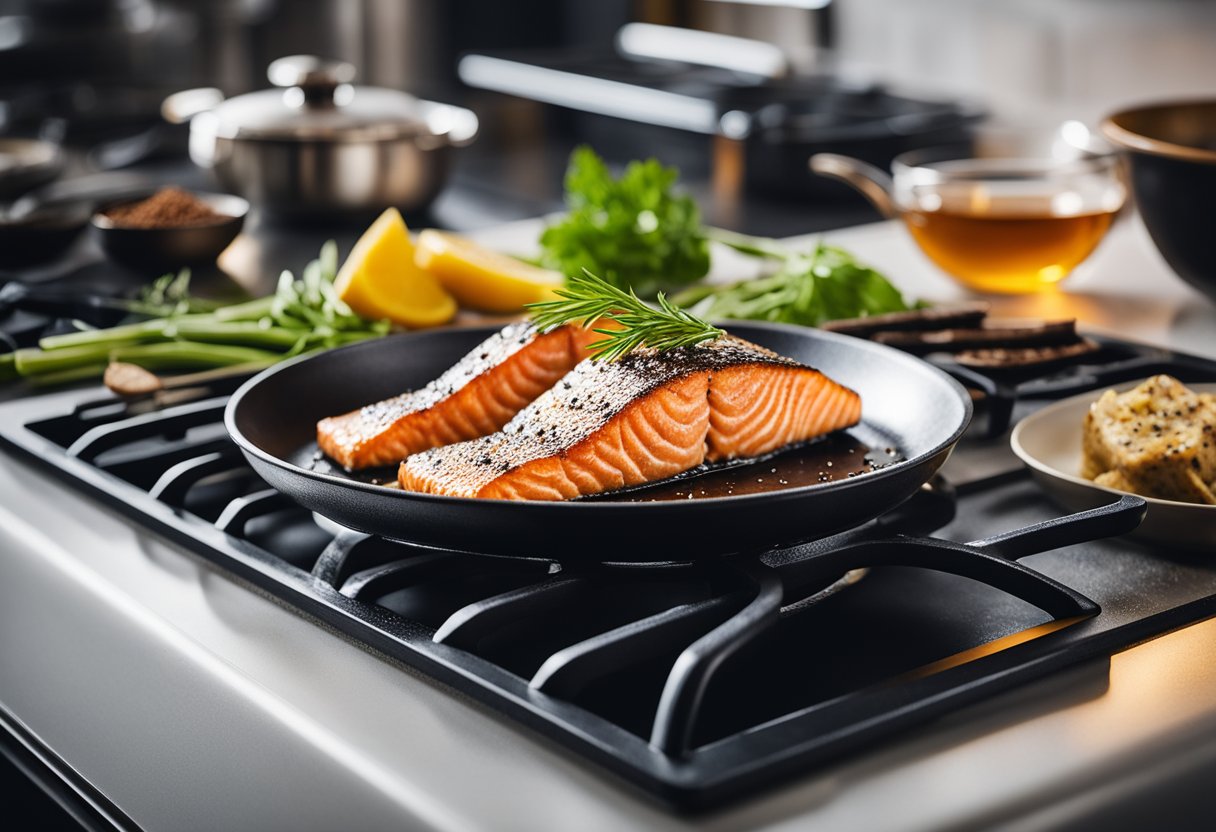
When it comes to storing and reheating Caramelized Salmon, following proper techniques is crucial to maintain its freshness and ensure food safety. Here are some tips to keep in mind:
Proper Storage Techniques
- Refrigeration: After cooking, allow the salmon to cool to room temperature for about 30 minutes before storing it in an airtight container. Place the container in the coldest part of your refrigerator and consume the salmon within 1-2 days.
- Freezing: If you have leftover Caramelized Salmon that you won’t be able to consume within 2 days, you can freeze it for later use. Wrap the salmon tightly in plastic or foil and place it in a freezer bag with minimal air. Consume the frozen salmon within 2-3 months for best quality.
Reheating Guidelines
- Microwave: Place the salmon in a microwave-safe dish and cover it with a damp paper towel. Heat it on high for 30 seconds, then check the temperature. Continue heating in 15-second increments until the salmon is heated through.
- Oven: Preheat your oven to 350°F. Place the salmon in an oven-safe dish and cover it with foil. Heat it for 10-15 minutes or until it’s heated through.
- Stovetop: Heat a non-stick pan over medium heat. Add a small amount of oil or butter and place the salmon in the pan. Heat it for 2-3 minutes on each side or until it’s heated through.
Remember to always consume fresh and cooked salmon within the recommended time frames for optimal freshness and safety. By following these simple tips, you can enjoy delicious Caramelized Salmon without worrying about food safety concerns.
Caramelized Salmon Variations
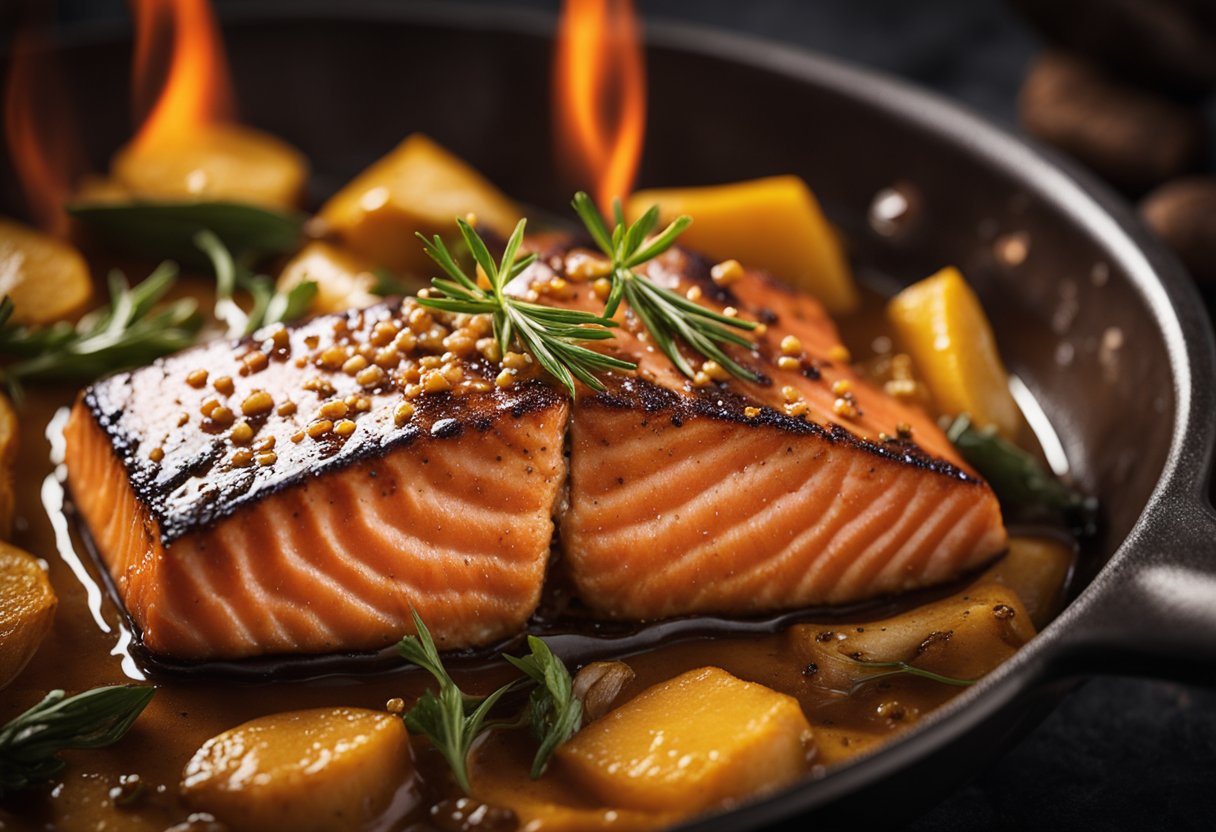
If you’re a fan of caramelized salmon, you’ll be happy to know that there are many variations to this delicious dish. From cultural twists to diet-specific adaptations, there are many ways to enjoy this flavorful meal.
Cultural Twists
Caramelized salmon is a dish that can be found in many cultures, each with their own unique take on the dish. For example, Vietnamese caramelized salmon, or Ca Hoi Kho, is a popular dish in Vietnamese cuisine. In this variation, the salmon is marinated in a mixture of fish sauce, sugar, and spices before being caramelized in a pan. This gives the salmon a sweet and savory flavor that is sure to please.
Another cultural twist on caramelized salmon is the Japanese dish Teriyaki salmon. In this variation, the salmon is marinated in a mixture of soy sauce, mirin, and sugar before being grilled or broiled. The result is a sweet and savory dish that is perfect for any occasion.
Diet-Specific Adaptations
If you’re following a specific diet, you’ll be happy to know that caramelized salmon can be adapted to fit your needs. For example, if you’re following a low-carb or keto diet, you can substitute the sugar in the recipe with a low-carb sweetener like erythritol or stevia. This will give you the same sweet and savory flavor without the added carbs.
If you’re following a gluten-free diet, you’ll be happy to know that caramelized salmon is naturally gluten-free. Just be sure to check the ingredients of any sauces or marinades you use to make sure they are also gluten-free.
In conclusion, caramelized salmon is a versatile dish that can be adapted to fit any taste or dietary need. Whether you’re looking for a cultural twist or a diet-specific adaptation, there are many ways to enjoy this delicious dish. For more information and recipe ideas, check out these external links, and start experimenting with your own variations today!
Frequently Asked Questions
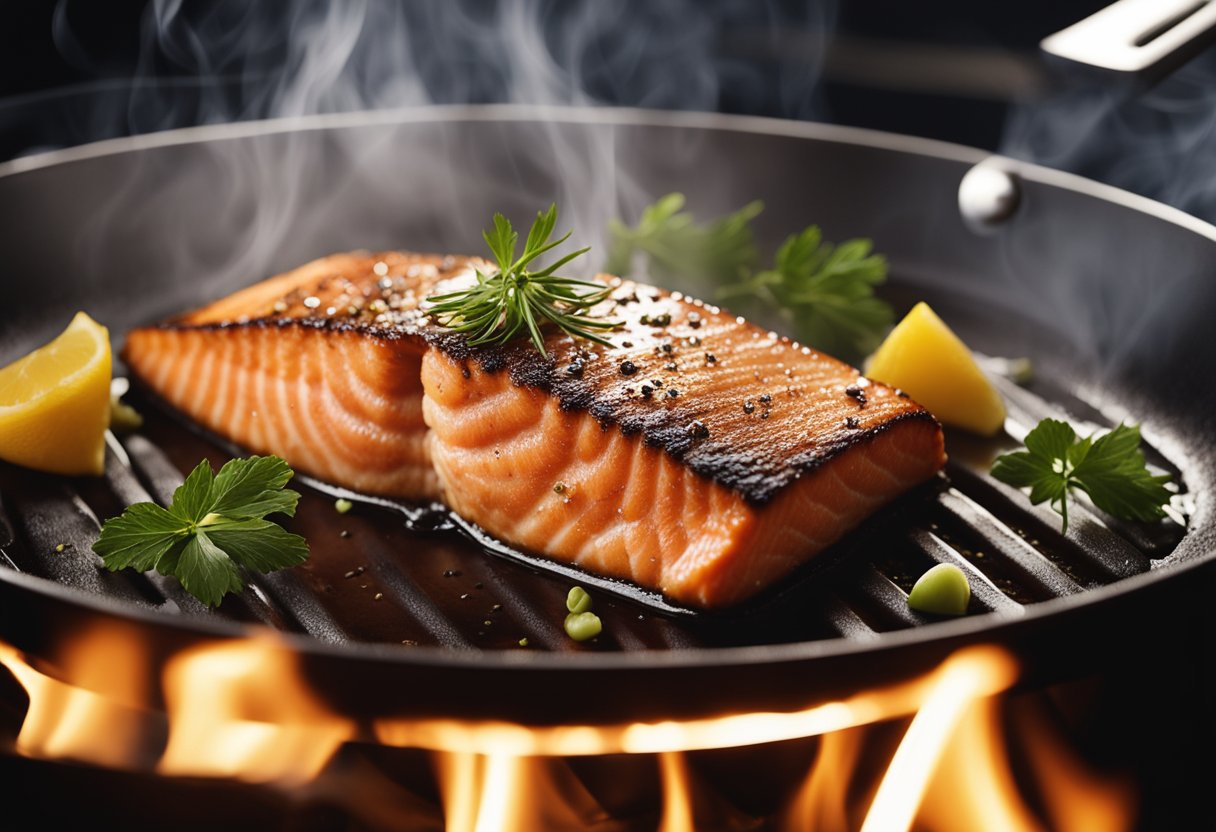
How can I achieve perfect caramelization when cooking salmon in the oven?
To achieve perfect caramelization when cooking salmon in the oven, make sure to preheat the oven to a high temperature and use a baking sheet lined with parchment paper. Coat the salmon with a mixture of brown sugar, soy sauce, and olive oil before placing it in the oven. Keep a close eye on the salmon and remove it from the oven as soon as it starts to caramelize.
What are some simple steps to make easy caramelized salmon at home?
To make easy caramelized salmon at home, start by seasoning the salmon fillets with salt and pepper. Then, coat the fillets with a mixture of brown sugar and olive oil. Heat a skillet over medium-high heat and cook the salmon for 3-4 minutes on each side until the sugar has caramelized and the fish is cooked through.
Which ingredients are essential for creating a Vietnamese-style caramelized salmon?
To create a Vietnamese-style caramelized salmon, you will need dark brown sugar, fish sauce, soy sauce, garlic, ginger, and lime juice. Combine these ingredients in a pan and cook until the sugar has caramelized. Add the salmon and cook until it is coated in the caramel sauce.
What is the best way to use honey in caramelizing salmon?
Honey can be used as a substitute for brown sugar in caramelizing salmon. Mix honey with soy sauce, olive oil, and other desired seasonings. Brush the mixture over the salmon before cooking and continue to brush it on as the fish cooks. Be careful not to let the honey burn as it can easily go from caramelized to burnt.
Can caramelized salmon be prepared using an air fryer, and if so, how?
Yes, caramelized salmon can be prepared using an air fryer. Season the salmon with salt and pepper and brush it with a mixture of brown sugar and olive oil. Place the salmon in the air fryer basket and cook at 375°F for 8-10 minutes until caramelized and cooked through.
What are the key techniques for grilling salmon to get a caramelized exterior?
To get a caramelized exterior when grilling salmon, start by preheating the grill to high heat. Brush the salmon with olive oil and season with salt and pepper. Place the salmon skin-side down on the grill and cook for 4-5 minutes until the skin is crispy. Flip the salmon and cook for an additional 2-3 minutes until caramelized and cooked through.
External Links
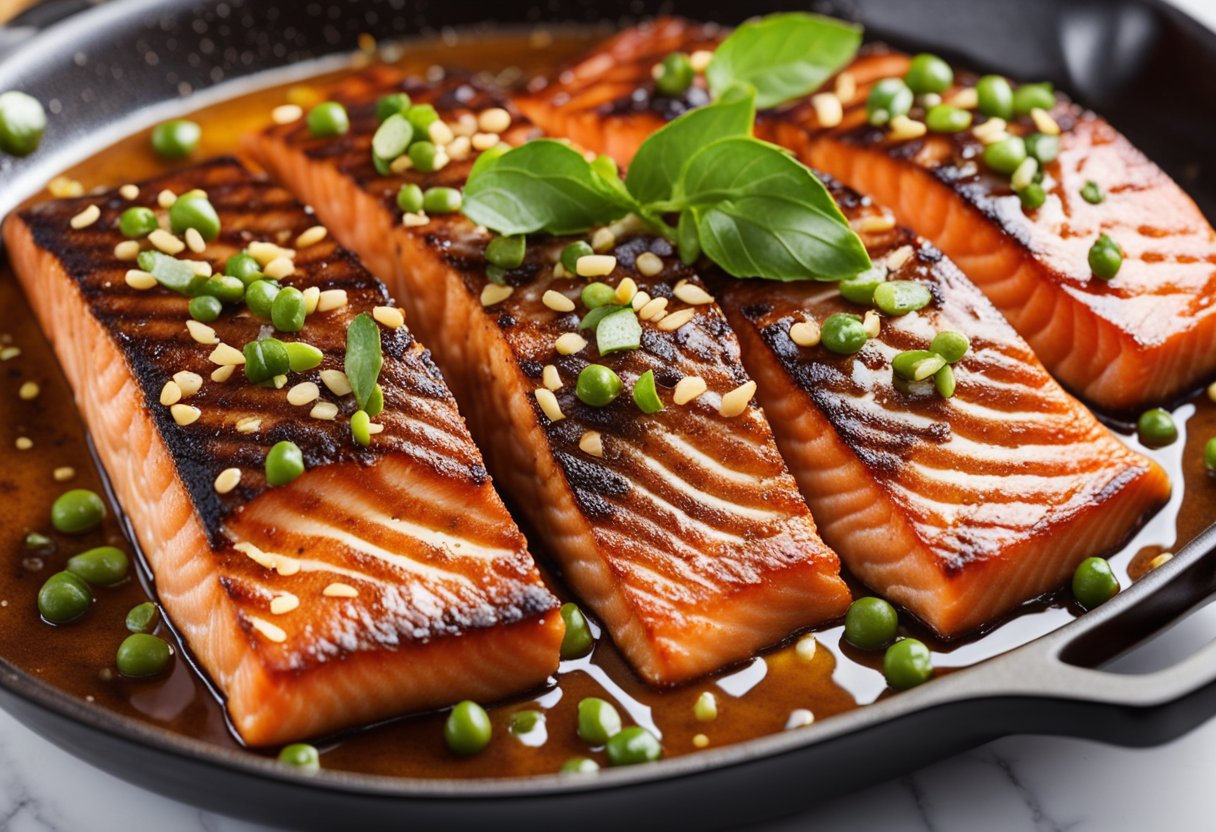
If you want to learn more about caramelized salmon, there are many external resources available online. Here are a few links to get you started:
- Pinch of Yum – This recipe blog provides a detailed recipe for caramelized salmon, complete with step-by-step instructions and photos. The recipe uses a mix of white and brown sugar, sea salt, black pepper, and nutmeg for the coating.
- Cooking Therapy – This recipe blog offers a Vietnamese-style caramelized salmon recipe that uses fish sauce, dark brown sugar, and oil for the coating. The salmon is marinated in fish sauce and pepper before being cooked in the caramel sauce.
- Give it Some Thyme – This recipe blog provides a simple recipe for caramelized salmon that uses a blend of white and brown sugar, sea salt, black pepper, and nutmeg for the coating. The recipe is quick and easy to make and is a great way to enjoy healthy, restaurant-quality salmon at home.
- Half Baked Harvest – This recipe blog offers a spicy ginger caramelized salmon bowl recipe that uses tamari, pickled ginger juice, fresh ginger, garlic, toasted sesame oil, and chili flakes for the marinade. The recipe can be served with rice or noodles and is a great way to enjoy a flavorful, healthy meal.
- Delightful Plate – This recipe blog provides a Vietnamese-style caramelized salmon recipe that uses fish sauce and caramel sauce to give the salmon a savory taste and beautiful color. The recipe is served with rice and is a satisfying meal that is easy to make.
These external links offer a variety of recipes and techniques for making caramelized salmon. Whether you prefer a simple recipe or something with a little more spice, there is sure to be a recipe that suits your taste.
More FAQs
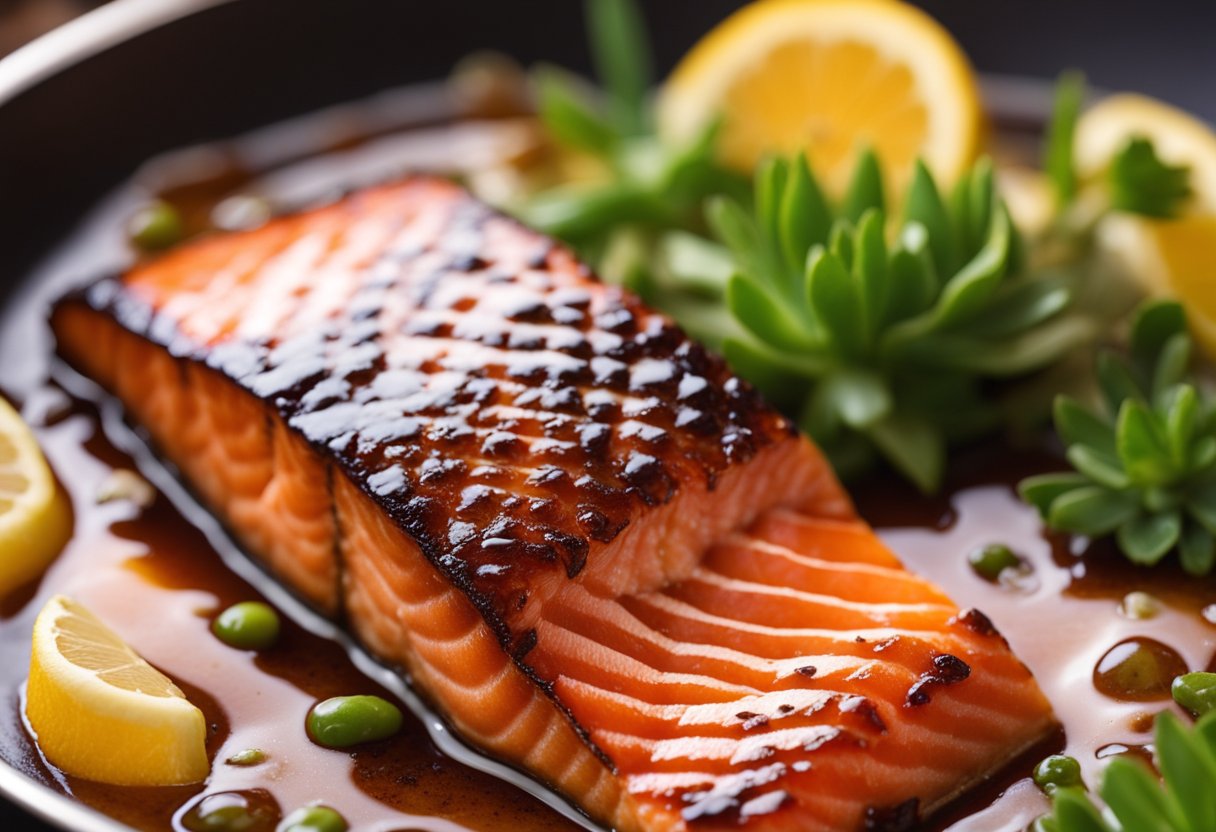
What makes salmon taste better?
Salmon tastes better when it is cooked perfectly. Overcooking salmon can make it dry and tough, while undercooking it can make it raw and unsafe to eat. To get perfectly cooked salmon, you need to use the right temperature and cooking time. You can also add some seasonings to enhance the flavor of the salmon. A blend of white and brown sugar, sea salt, black pepper, and a dash of nutmeg is a great coating for salmon. It gives the salmon a caramelized flavor and makes it taste delicious.
What goes well with baked salmon?
Baked salmon is a versatile dish that can be paired with a variety of sides. Some great options include roasted vegetables, rice, or quinoa. You can also serve it with a side salad or a creamy sauce. Lemon butter sauce is a classic choice that goes well with baked salmon. It adds a tangy and buttery flavor to the dish. You can also try a honey mustard sauce or a dill sauce for a different flavor profile.
What makes salmon unusual?
Salmon is an unusual fish because it is anadromous, which means it spends most of its life in the ocean but returns to freshwater rivers and streams to spawn. This unique lifecycle gives salmon a distinct flavor and texture. It also makes it a popular choice for seafood lovers. Salmon is rich in omega-3 fatty acids, which are essential for brain health and can help reduce inflammation in the body.
How to cook salmon for best results?
To cook salmon for best results, you need to follow a few simple steps. First, preheat your oven to 425°F. Then, season your salmon with salt and pepper, or a blend of white and brown sugar, sea salt, black pepper, and a dash of nutmeg. Place the salmon on a baking sheet lined with parchment paper and bake for 12-15 minutes, or until the salmon is cooked through. You can also pan-sear salmon for a crispy crust. Heat a skillet over medium-high heat and add some oil. Place the salmon in the skillet skin-side down and cook for 3-4 minutes, or until the skin is crispy. Flip the salmon and cook for an additional 2-3 minutes, or until the salmon is cooked through.
Conclusion
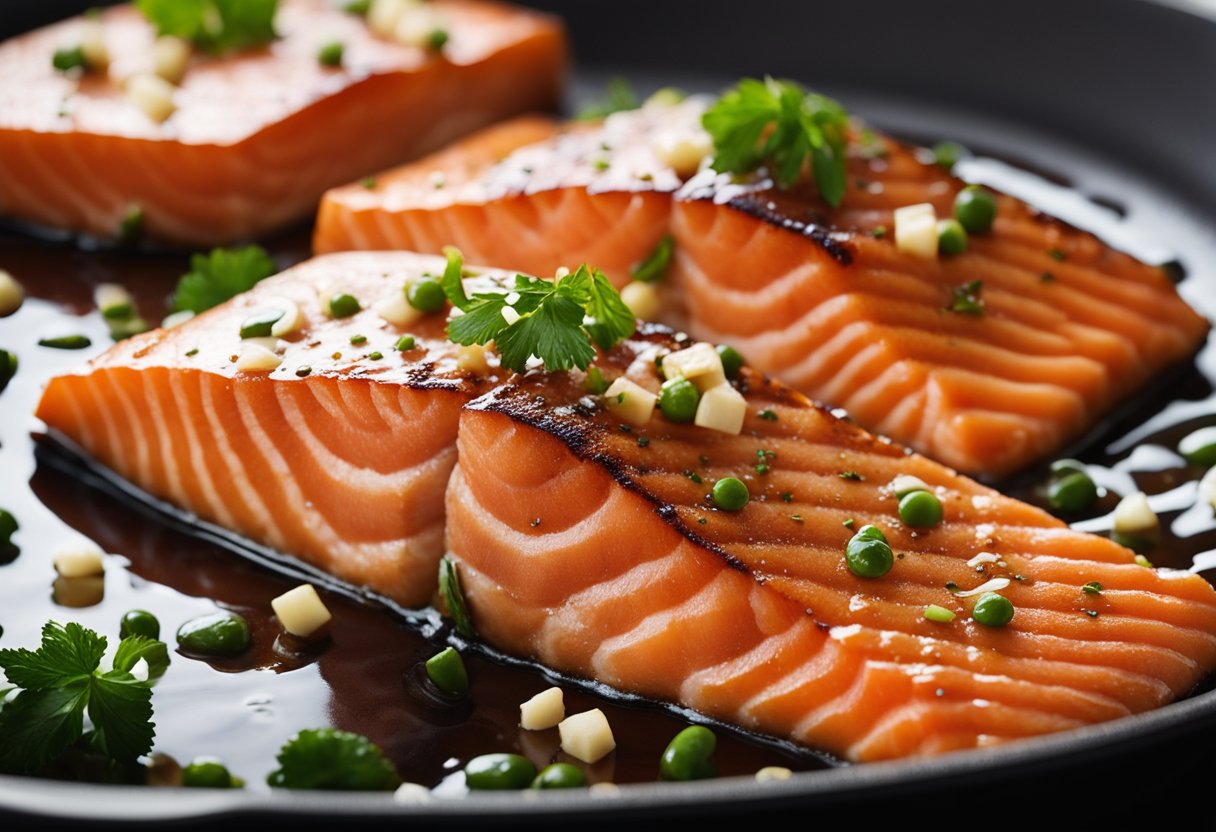
In conclusion, caramelized salmon is a delicious and healthy dish that you can easily prepare at home. With just a few simple ingredients and some basic cooking skills, you can create a flavorful and nutritious meal that your whole family will love.
To recap, caramelizing salmon involves coating the fish with a mixture of sugar, salt, and pepper, and then cooking it on the grill or in the oven until it develops a sweet and crispy crust. You can also experiment with different seasonings and marinades to add even more flavor to your dish.
When it comes to serving your caramelized salmon, you can pair it with a variety of sides, such as roasted vegetables, rice, or a fresh salad. You can also use it as a protein source in sandwiches, wraps, or tacos.
Overall, caramelized salmon is a versatile and tasty dish that you can enjoy any time of the year. Whether you’re looking for a quick and easy weeknight meal or a show-stopping dish to impress your dinner guests, caramelized salmon is a great choice. So why not give it a try and see for yourself how delicious and satisfying this dish can be?
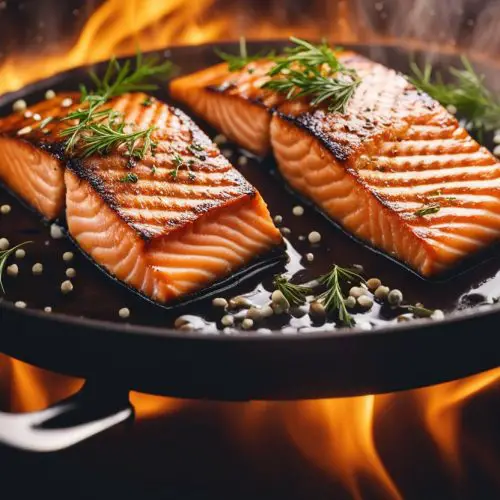
Caramelized Salmon
Ingredients
- 4 salmon fillets
- 1/4 cup brown sugar
- 3 tablespoons soy sauce
- 2 tablespoons Dijon mustard
- 2 tablespoons olive oil
- 2 cloves garlic, minced
- 1 teaspoon ginger, grated
- Salt and pepper to taste
- Chopped fresh parsley for garnish
Instructions
- Preheat the oven to 375°F (190°C).
- In a small bowl, mix together brown sugar, soy sauce, Dijon mustard, olive oil, minced garlic, and grated ginger.
- Place the salmon fillets on a baking sheet lined with parchment paper or aluminum foil.
- Season the salmon fillets with salt and pepper.
- Brush the brown sugar mixture over the salmon fillets, coating them evenly.
- Bake in the preheated oven for 15-20 minutes or until the salmon is cooked through and caramelized on top.
- Garnish with chopped fresh parsley before serving.

